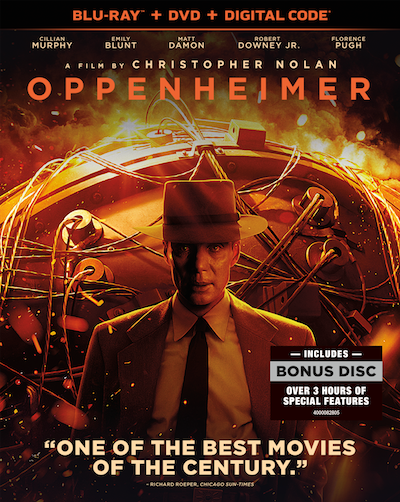
No one could have possibly predicted the phenomenon known as “Barbenheimer.” One picture was a biopic about the tortured genius who gave birth to the atomic age, written and directed by one of the most successful blockbuster filmmakers of recent memory. The other was a candy colored feminist treatise based on a popular plastic doll from a pair of indie film darlings. Regardless of the glaring differences, Barbie and Oppenheimer share a common theme as both films feature a conflicted titular protagonist dealing with a public that both idolized and vilified them.
Cillian Murphy takes on the role of J. Robert Oppenheimer, who once famously quoted Hindu scripture when he declared, “Now I am become death, the destroyer of worlds.” Christopher Nolan’s epic biopic begins with Oppenheimer as a student at Cambridge where he injects potassium cyanide in his professor’s apple for nearly denying him the chance to meet famed physicist Niels Bohr (Kenneth Branagh). Thankfully, the attempted poisoning is aborted. From there, Oppenheimer begins teaching at Berkeley where he grows from a single student to a class full of enraptured young minds. He also begins a tumultuous affair with psychiatrist Jean Tatlock (Florence Pugh) after they meet at a fundraiser for the Communist Party.
In 1942, Oppenheimer is recruited by General Leslie Groves (Matt Damon), who previously oversaw the construction of the Pentagon, to head up the Manhattan Project. The sole purpose is to create the world’s first atomic bomb before the Germans. Under Oppenheimer’s direction, the Army constructed an entire town in the desert of Los Alamos, New Mexico to serve as a research facility and living quarters for staff and their families. Many of Oppenheimer’s peers, including future Nobel Prize winner Isidor Isaac Rabi (David Krumholtz), are apprehensive about harnessing such a weapon, but are solemnly reminded of the dangers should Hitler possess atomic power. There’s also a tiny possibility that the detonation of an atomic bomb would ignite the Earth’s atmosphere and end all life as we know it.
Even after the Furher’s death and Germany’s surrender, the Manhattan Project plows on as it is widely believed Japan would never surrender. Following a successful test, two bombs are dropped on Hiroshima and Nagasaki to officially end World War II. The widespread destruction and loss of life haunts Oppenheimer as does the oncoming arms race to build even more destructive weapons, specifically the hydrogen bomb. This leads him to become an outspoken critic against the proliferation of nuclear arms.
The main narrative is framed against two future events, both shot in stark black and white. In 1954, Oppenheimer is called before a private hearing due to his previous ties with known socialists. In spite of staunch defense from wife Kitty (Emily Blunt) and Groves, the hearing revokes his security clearance and undercuts his political influence. In 1959, the story takes us to the confirmation hearings for Lewis Strauss (Robert Downey Jr.), a retired admiral up for Secretary of Commerce. Strauss had previously worked with Oppenheimer at Princeton and the Atomic Energy Commission. It is at the confirmation hearings we learn Strauss spearheaded Oppenheimer’s downfall as revenge for the latter’s disagreeing with the former’s policies. There’s also a perceived slight that Oppenheimer badmouthed Strauss to the legendary Albert Einstein (Tom Conti).
Oppenheimer packs a lot of information, names, and historical facts into a runtime of just over 3 hours. However, the film moves at a brisk pace while maintaining tension and intrigue. Nolan’s bombastic directing style obviously works well in depicting the historic detonation of the atomic bomb. Yet, the most intimate of moments also work well, including the claustrophobia and uncomfortable nature of the secret hearings. In particular, the haunting image of Cillian Murphy’s gaunt face, along with his piercing blue eyes, depicted in IMAX is unforgettable. Murphy’s subdued performance is perfectly complemented by Emily Blunt’s fierce portrayal of Kitty Oppenheimer. The supporting cast is an embarrassment of riches that includes Jason Clarke, Tony Goldwyn, Josh Hartnett, Jack Quaid, Dane DeHaan, Alden Ehrenreich, Matthew Modine, James Remar, and David Dastmalchian.
Video/Audio: 10
The video is presented in 1080p with alternating aspect ratios of 2.20:1 and IMAX 1.78:1. The picture quality is extraordinary with a very fine grain that is unique to being shot on actual film. From every crevice and crease in Cillian Murphy’s face to the sun setting in the background of a still under construction Los Alamos, details are immaculately rendered.
The audio is presented in DTS-HD Master Audio 5.1. The sound design is brilliant beginning with the silence followed by a sonic boom during the Trinity test. Nolan drowns pivotal scenes with overwhelming rumbling or eerie silence. Ludwig Goransson’s score feels the same, music that is alternately haunting and triumphant.
Special Features: 7
The Story of Our Time: The Making of Oppenheimer (1:12:25) is a brilliant 7-part documentary that takes us behind the scenes of the film. The doc takes us through the real historical figures and the A-list cast that portrays them, shooting in the IMAX format, wardrobe, production design, and score.
Innovations in Film: 65mm Black and White Film in Oppenheimer (8:21) looks at the creation of a black & white film stock in the 65mm format and why it’s important to shoot on film.
Meet the Press Q&A Panel: Oppenheimer (34:36) is a discussion about the film, its historical accuracy, and real world implications with Christopher Nolan, physicists Kip Thorn & Carlo Rovelli, director of the Los Alamos National Laboratory Thomas Mason, and Kai Bird, the co-author of American Prometheus, which was the basis for Nolan’s script.
To End All War: Oppenheimer & The Atomic Bomb (1:27:18) is a fascinating documentary about Oppenheimer, the creation of the atomic bomb, and the effects it had on the man’s psyche. The documentary includes archival footage of Oppenheimer and other individuals featured in the film.
Rounding out the disc are four trailers for Oppenheimer and a “Special Look” preview.
Film Value: 8
Christopher Nolan has constructed his own masterpiece, intricately crafted with a wealth of moving parts. Every element is firing on all cylinders from the acting, cinematography, shot composition, score, and sound design. Nolan accomplished an amazing feat in distilling one man’s life and major historical events into a riveting three hour film.

